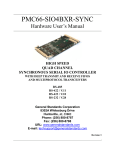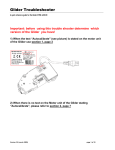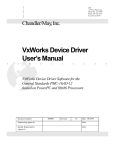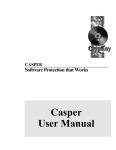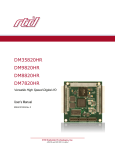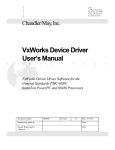Download PMC-16AO16 LINUX Device Driver User Manual
Transcript
16AO16 16-Bit, 16 Channel High-Speed Analog Output Board PMC-16AO16 LINUX Device Driver User Manual Manual Revision: July 28, 2005 General Standards Corporation 8302A Whitesburg Drive Huntsville, AL 35802 Phone: (256) 880-8787 Fax: (256) 880-8788 URL: http://www.generalstandards.com E-mail: [email protected] E-mail: [email protected] PMC-16AO16 LINUX Device Driver User’s Manual Preface Copyright ©2003-2005, General Standards Corporation Additional copies of this manual or other literature may be obtained from: General Standards Corporation 8302A Whitesburg Dr. Huntsville, Alabama 35802 Phone: (256) 880-8787 FAX: (256) 880-8788 URL: http://www.generalstandards.com E-mail: [email protected] General Standards Corporation makes no warranty of any kind with regard to this material, including, but not limited to, the implied warranties of merchantability and fitness for a particular purpose. Although extensive editing and reviews are performed before release to ECO control, General Standards Corporation assumes no responsibility for any errors that may exist in this document. No commitment is made to update or keep current the information contained in this document. General Standards Corporation does not assume any liability arising out of the application or use of any product or circuit described herein, nor is any license conveyed under any patent rights or any rights of others. General Standards Corporation assumes no responsibility for any consequences resulting from omissions or errors in this manual or from the use of information contained herein. General Standards Corporation reserves the right to make any changes, without notice, to this product to improve reliability, performance, function, or design. ALL RIGHTS RESERVED. The Purchaser of this software may use or modify in source form the subject software, but not to re-market or distribute it to outside agencies or separate internal company divisions. The software, however, may be embedded in the Purchaser’s distributed software. In the event the Purchaser’s customers require the software source code, then they would have to purchase their own copy of the software. General Standards Corporation makes no warranty of any kind with regard to this software, including, but not limited to, the implied warranties of merchantability and fitness for a particular purpose and makes this software available solely on an “as-is” basis. General Standards Corporation reserves the right to make changes in this software without reservation and without notification to its users. The information in this document is subject to change without notice. This document may be copied or reproduced provided it is in support of products from General Standards Corporation. For any other use, no part of this document may be copied or reproduced in any form or by any means without prior written consent of General Standards Corporation. GSC is a trademark of General Standards Corporation. PLX and PLX Technology are trademarks of PLX Technology, Inc. 2 General Standards Corporation, Phone: (256) 880-8787 PMC-16AO16 LINUX Device Driver User’s Manual Table of Contents 1. Introduction............................................................................................................................... 5 1.1. Purpose ..............................................................................................................................................................5 1.2. Acronyms...........................................................................................................................................................5 1.3. Definitions..........................................................................................................................................................5 1.4. Software Overview............................................................................................................................................5 1.5. Hardware Overview..........................................................................................................................................5 1.6. Reference Material............................................................................................................................................5 2. Installation ................................................................................................................................. 6 2.1. CPU and Kernel Support .................................................................................................................................6 2.2. The Driver .........................................................................................................................................................6 2.2.1. Installation on Target System .......................................................................................................................6 2.2.2. Building the driver and test application........................................................................................................6 2.2.3. Manual Startup .............................................................................................................................................6 2.2.4. Automatic startup .........................................................................................................................................7 2.2.5. Verification of startup...................................................................................................................................7 2.2.6. Verification...................................................................................................................................................7 2.2.7. Removal........................................................................................................................................................8 2.2.8. Uninstall .......................................................................................................................................................8 3. Sample Application................................................................................................................... 9 4. Driver Interface....................................................................................................................... 10 4.1. Registers...........................................................................................................................................................10 4.1.1. GSC Registers ............................................................................................................................................10 4.1.2. PLX PCI 9056 Registers.............................................................................................................................10 4.2. Data Types .......................................................................................................................................................10 4.2.1. REGISTER_PARAMS...............................................................................................................................10 4.3. read()................................................................................................................................................................11 4.4. write()...............................................................................................................................................................11 4.5. ioctl() ................................................................................................................................................................12 4.5.1. IOCTL_NO_COMMAND .........................................................................................................................12 4.5.2. IOCTL_READ_REGISTER ......................................................................................................................13 4.5.3. IOCTL_WRITE_REGISTER.....................................................................................................................13 4.5.4. IOCTL_INIT_BOARD ..............................................................................................................................13 4.5.5. IOCTL_SET_DMA_MODE ......................................................................................................................13 4.5.6. IOCTL_GET_DEVICE_ERROR...............................................................................................................14 4.5.7. IOCTL_AUTOCALIBRATE.....................................................................................................................14 4.5.8. IOCTL_PROGRAM_RATE_GEN ............................................................................................................14 4.5.9. IOCTL_CHANNEL_ENABLE..................................................................................................................14 4.5.10. IOCTL_SET_OUT_BUFFER_SIZE........................................................................................................15 4.5.11. IOCTL_GET_BUFFER_STATUS...........................................................................................................15 4.5.12. IOCTL_ENABLE_CLK...........................................................................................................................16 4.5.13. IOCTL_DISABLE_CLK..........................................................................................................................16 4.5.14. IOCTL_SELECT_DATA_FORMAT ......................................................................................................16 3 General Standards Corporation, Phone: (256) 880-8787 PMC-16AO16 LINUX Device Driver User’s Manual 4.5.15. IOCTL_SELECT_SAMPLING_MODE..................................................................................................16 4.5.16. IOCTL_GET_BURSTING_STATUS......................................................................................................17 4.5.17. IOCTL_BURST_TRIGGER ....................................................................................................................17 4.5.18. IOCTL_ENABLE_REMOTE_GND_SENSE..........................................................................................17 4.5.19. IOCTL_DISABLE_LOCAL_GND_SENSE............................................................................................17 4.5.20. IOCTL_SELECT_OUT_CLKING_MODE.............................................................................................18 4.5.21. IOCTL_SELECT_CLK_SOURCE ..........................................................................................................18 4.5.22. IOCTL_GET_CLK_STATUS..................................................................................................................18 4.5.23. IOCTL_SINGLE_OUTPUT_CLK_EVENT............................................................................................18 4.5.24. IOCTL_SELECT_BUF_CONFIG ...........................................................................................................19 4.5.25. IOCTL_LOAD_ACCESS_REQ ..............................................................................................................19 4.5.26. IOCTL_GET_CIR_BUF_STATUS .........................................................................................................19 4.5.27. IOCTL_CLEAR_BUFFER ......................................................................................................................19 4.5.28. IOCTL_GET_DEVICE_TYPE ................................................................................................................20 4.5.29. IOCTL_SET_TIMEOUT .........................................................................................................................20 4.5.30. IOCTL_SET_OUTPUT_RANGE............................................................................................................20 Document History ....................................................................................................................... 21 4 General Standards Corporation, Phone: (256) 880-8787 PMC-16AO16 LINUX Device Driver User’s Manual 1. Introduction 1.1. Purpose The purpose of this document is to describe the interface to the 16AO16 Linux device driver. This software provides the interface between application software and the 16AO16 board. 1.2. Acronyms The following is a list of commonly occurring acronyms used throughout this document. Acronyms DMA PCI Description Direct Memory Access Peripheral Component Interconnect 1.3. Definitions The following is a list of commonly occurring terms used throughout this document. Term Driver Application Definition Driver means the kernel mode device driver, which runs in the kernel space with kernel mode privileges. Application means the user mode process, which runs in the user space with user mode privileges. 1.4. Software Overview The 16AO16 driver software executes under control of the Linux operating system. The device driver allows the user to open and close one or more 16AO16 boards, then read and write data to the registers on the hardware. 1.5. Hardware Overview The 16AO16 is a 16-Bit, 16 channel high-speed analog output board. See the hardware manual for a detailed description of the hardware features. 1.6. Reference Material The following reference material may be of particular benefit in using the 16AO16 and this driver. The specifications provide the information necessary for an in depth understanding of the specialized features implemented on this board. • The applicable 16AO16 User Manual from General Standards Corporation. • The PCI9056 PCI Bus Master Interface Chip data handbook from PLX Technology, Inc. PLX Technology Inc. 870 Maude Avenue Sunnyvale, California 94085 USA Phone: 1-800-759-3735 WEB: http://www.plxtech.com 5 General Standards Corporation, Phone: (256) 880-8787 PMC-16AO16 LINUX Device Driver User’s Manual 2. Installation 2.1. CPU and Kernel Support The driver is a Linux kernel-mode module. The driver has been tested on a PC system with dual Intel x86 processors running kernel 2.4.18-14SMP, and 2.6.11-1.35FC3smp. Support for the 2.2 kernel has been left in the driver, but has not been built or tested. The driver will have to be rebuilt for the version of the kernel running on the target machine. 2.2. The Driver This driver and its related files are: File *.c plx_regs.h README.TXT Internals.h gsc16ao16_ioctl.h sysdep.h gsc_start app.mak Makefile Description The driver source files. Defines for the PLX chip, used internally by the driver. Revision history and late-breaking news. Internal defines for the driver. Defines common to the driver and the application. This is the only header file that needs to be included in the application. Compatibility file for 2.2, 2.4 and 2.6 kernels. Script to detect how many 16AO16 boards are installed, and create a node for each of the cards. Makefile for the test application. Invoked as ‘make –f app.mak’ Makefile for the driver. Invoked as simply ‘make’ or ‘make –f Makefile’ 2.2.1. Installation on Target System To install the driver: 1. Power down the target computer and install the 16AO16 hardware card(s). 2. Power up the system. 3. Decompress the distribution tar file in a convenient directory. To decompress the archive, use a command like: tar –xzvf gsc_16ao16Driver.tar.gz 2.2.2. Building the driver and test application To build the driver, change to the directory containing the driver source. Then: 1. Type make to build the driver. The driver should build without errors or warnings. If there are warnings or errors, ensure that the current kernel source is located at /usr/src/linux-2.4, or whatever settings are required for other versions of the kernel. 2. Type make –f app.mak to build the test application. 2.2.3. Manual Startup Login as root. Type ./gsc_start to start the driver. The script will display: 6 General Standards Corporation, Phone: (256) 880-8787 PMC-16AO16 LINUX Device Driver User’s Manual Loading module 16AO ... 2.2.4. Automatic startup The 16AO16 driver may also be started automatically upon reboot. For auto-start using the 2.4 kernel, edit the file /etc/rc.d/rc.local and add the line /<path>/gsc_start where <path> is the path to where the driver and startup script are installed. Note that the startup script must be in the same directory as the driver for the startup script to work. 2.2.5. Verification of startup There are three ways to verify that the driver has started. The first is to type: ls /dev/16ao* The operating system will list an entry for each board installed, such as: /dev/16AO0 The number appended to the name (0,1,…) is the index of the card. When multiple devices are present in the system, this is how the application specifies which device to open. The second method is to check the /proc file system. The 16AO driver creates an entry in the /proc file system to report the number of boards found and the build date of the driver. Typing: cat /proc/16AO Returns a result similar to: version: 2.0 built: Aug 26 2003, 11:06:29 If the driver is a debug build, additional statistics are reported in the proc file. The third method is to check the loaded modules by typing: lsmod The 16AO will be listed as one of the installed modules. 2.2.6. Verification The distribution includes a test application and source called testapp. Run this application to verify that the installation was successful. The board will be opened, reset and the configuration register will be read. To run the application, type: ./testapp 0 Where 0 is the index for the first (or only) 16AO family board installed in the system. Testapp will display a result similar to: about to open /dev/gsc_16ao0 open OK - board type: GSC16AO1616 channels: 12 before reset: BCR is 0x10 7 General Standards Corporation, Phone: (256) 880-8787 PMC-16AO16 LINUX Device Driver User’s Manual board reset OK after reset: BCR is 0x10 auto calibration OK before PIO write after PIO write before DMA write after DMA write 2.2.7. Removal Follow the below steps to remove the driver. 1. Type: rmmod 2. Verify that the driver has been removed by typing: lsmod And verifying that the driver is no longer listed. 2.2.8. Uninstall First remove the driver as described above. Remove the auto-start entry in /etc/rc.d/rc.local. Delete the directory containing the driver, startup script and source. 8 General Standards Corporation, Phone: (256) 880-8787 PMC-16AO16 LINUX Device Driver User’s Manual 3. Sample Application The sample application demonstrates opening the driver, and reading and writing registers using the IOCTL service. Data may be written to and read from the other registers on the hardware using similar code. 9 General Standards Corporation, Phone: (256) 880-8787 PMC-16AO16 LINUX Device Driver User’s Manual 4. Driver Interface The 16AO16 driver conforms to the device driver standards required by the LINUX driver model. The device driver provides a standard driver interface to the GSC 16AO16 board for Linux applications. The interface includes various macros, data types and functions, all of which are described in the following paragraphs. The 16AO16 specific portion of the driver interface is defined in the header file 16ao16_ioctl.h, portions of which are described in this section. The header defines numerous items in addition to those described here. NOTE: Contact General Standards Corporation if additional driver functionality is required. 4.1. Registers The following table gives the complete set of 16AO16 registers. The tables are divided by register categories. All registers are accessed as 32-bits. 4.1.1. GSC Registers The following table gives the complete set of GSC specific 16AO16 registers. For detailed definitions of these registers refer to the 16AO16 User Manual. The macro fields are defined to simplify access to the registers. Macro BOARD_CTRL_REG CHANNEL_SELECTION_REG RATE_CTRL_REG BUFFER_OPS_REG RESERVED_1 RESERVED_2 OUTPUT_BUF_REG ADJUSTABLE_CLOCK Description Board Control Register (BCR) Channel Select Register (CSR) Sample Rate Register (SCR) Buffer Operations Register (BOR) Not Used Not Used Output Buffer Register (ODB) Clock Control Register (ACR) (Optional) 4.1.2. PLX PCI 9056 Registers For detailed definitions of these registers refer to the PCI9056 Data Book. There is rarely any need to examine the PLX registers; they are mentioned here for completeness. 4.2. Data Types This driver interface includes the following data types, which are defined in gsc16ao16_ioctl.h. 4.2.1. REGISTER_PARAMS This is the data structure used to move data back and forth between the application and the 16AO16 registers. Definition typedef struct REGISTER_PARAMS { ULONG eRegister; ULONG ulValue; } REGISTER_PARAMS, *REGISTER_PARAMS; Field eRegister Description The register to read or write. This is the 32-bit address, not the 8-bit address shown in the 10 General Standards Corporation, Phone: (256) 880-8787 PMC-16AO16 LINUX Device Driver User’s Manual hardware documentation. The register macros are 32-bit addresses The value to be written to the register on write, or the value read from the register on read. ulValue 4.3. read() The 16AO16 does not support a read operation, as the board has neither data storage nor synchronous data reception capability. Reading data from the appropriate registers is done using the ioctl function. 4.4. write() The write() function is used to transfer data from the user buffer to the hardware output buffer. The hardware output buffer drives the D/A output circuits. The driver only checks one thing about the state of the output buffer: Whether the “low quarter” bit is set in Board Control Register. To avoid overrunning the buffer, the driver will only write to the buffer if the status flag indicates that the buffer level is below the threshold. If the buffer level is greater than the threshold, the driver will set and interrupt and sleep until the level drops below the threshold. Prototype int write(int fd, void *buf, size_t count); Argument fd buf count Description This is the file descriptor of the device to access. Pointer to the user data buffer. Requested number of bytes to write. This must be a multiple of four (4). Return Value Less than 0 Greater than 0 Description An error occurred. Consult errno. The operation succeeded. Return value is bytes written. Example: #include #include #include #include #include <errno.h> <stddef.h> <stdio.h> <unistd.h> "gsc16ao1616_ioctl.h" int 16aio12_write(int fd, __u32 *buf, size_t samples) { size_t bytes; int status; bytes status = samples * 4; = write(fd, buf, bytes); if (status == -1) printf("write() failure, errno = %d\n", errno); else status /= 4; // convert bytes to words return(status); } 11 General Standards Corporation, Phone: (256) 880-8787 PMC-16AO16 LINUX Device Driver User’s Manual 4.5. ioctl() This function is the entry point to performing setup and control operations on an AO12 family board. This function should only be called after a successful open of the device. The general form of the ioctl call is: int ioctl(int fd, int command); or int ioct(int fd, int command, arg*); where: fd File handle for the driver. Returned from the open() function. command The command to be performed. arg* (optional) pointer to parameters for the command. Commands that have no parameters (such as IOCTL_GSC_NO_COMMAND) will omit this parameter, and use the first form of the call. The specific operation performed varies according to the command argument. The command argument also governs the use and interpretation of any additional arguments. The set of supported ioctl services is defined in the following sections. Usage of all IOCTL calls is similar. Below is an example of a call using IOCTL_READ_REGISTER to read the contents of the board control register (BCR): #include "ao12_ioctl.h" int ReadTest(int fd) { device_register_params RegPar; int res; regdata.eRegister = BOARD_CTRL_REG; regdata.ulValue = 0x0000; // to make sure it changes. res = ioctl(fd, (unsigned long) IOCTL_READ_REGISTER, ®data); if (res < 0) { printf("%s: ioctl IOCTL_READ_REGISTER failed\n", argv[0]); } return (res); 4.5.1. IOCTL_NO_COMMAND This is an empty driver entry point. This ioctl may be given to verify that the driver is correctly installed and that a 16AO16 device has been successfully opened. If an error status is returned verify that the driver was opened properly. 12 General Standards Corporation, Phone: (256) 880-8787 PMC-16AO16 LINUX Device Driver User’s Manual Usage ioctl() Argument Operation Arg Description IOCTL_NO_COMMAND None 4.5.2. IOCTL_READ_REGISTER This operation reads the selected register and returns the value. Refer to gsc16ao16_ioctl.h for a complete list of the accessible registers. Usage ioctl() Argument Operation Arg Description IOCTL_READ_REGISTER REGISTER_PARAMS* 4.5.3. IOCTL_WRITE_REGISTER This service writes a value to a 16AO16 register. The accessible registers are listed in gsc16ao16_ioctl.h. Usage ioctl() Argument request Arg Description IOCTL_WRITE_REGISTER REGISTER_PARAMS* 4.5.4. IOCTL_INIT_BOARD This service initializes the hardware to a known state. Usage ioctl() Argument request Arg Description IOCTL_INIT_BOARD None 4.5.5. IOCTL_SET_DMA_MODE This service selects the mode for writing data to the output buffer, either DMA or PIO (Programmed I/O). Possible choices are: DMA_DISABLE DMA_ENABLE Usage ioctl() Argument Request Arg Description IOCTL_SET_DMA_MODE Unsigned long* 13 General Standards Corporation, Phone: (256) 880-8787 PMC-16AO16 LINUX Device Driver User’s Manual 4.5.6. IOCTL_GET_DEVICE_ERROR This service returns the most recent error detected by the hardware. Possible return values are: NO_ERR INVALID_PARAMETER_ERR RESOURCE_ERR BOARD_ACCESS_ERR DEVICE_ADD_ERR ALREADY_OPEN_ERR INVALID_BOARD_STATUS_ERR FIFO_BUFFER_ERR Usage ioctl() Argument request Arg Description IOCTL_GET_DEVICE_ERROR Unsigned long* 4.5.7. IOCTL_AUTOCALIBRATE This service performs an autocalibration service on the hardware. The IOCTL waits for the “done” interrupt before returning. Usage ioctl() Argument request Arg Description IOCTL_AUTOCALIBRATE Unsigned long* 4.5.8. IOCTL_PROGRAM_RATE_GEN This service writes the passed value to the rate generator register. See the hardware manual for a description of how to select a value for the rate generator. Usage ioctl() Argument request Arg Description IOCTL_PROGRAM_RATE_GEN Unsigned long* 4.5.9. IOCTL_CHANNEL_ENABLE This service selects what channels will be written during a write cycle. Individual channel masks should be OR-ed together. Possible values are: CHAN_0_ENABLE CHAN_1_ENABLE CHAN_2_ENABLE CHAN_3_ENABLE CHAN_4_ENABLE 14 General Standards Corporation, Phone: (256) 880-8787 PMC-16AO16 LINUX Device Driver User’s Manual CHAN_5_ENABLE CHAN_6_ENABLE CHAN_7_ENABLE CHAN_8_ENABLE CHAN_9_ENABLE CHAN_10_ENABLE CHAN_11_ENABLE CHAN_12_ENABLE CHAN_13_ENABLE CHAN_14_ENABLE CHAN_15_ENABLE CHAN_ALL_ENABLE Usage ioctl() Argument Request Arg Description IOCTL_CHANNEL_ENABLE Unsigned long* 4.5.10. IOCTL_SET_OUT_BUFFER_SIZE This service sets the size of the virtual output buffer. Possible values are: OUT_BUFFER_SIZE_4 OUT_BUFFER_SIZE_8 OUT_BUFFER_SIZE_16 OUT_BUFFER_SIZE_32 OUT_BUFFER_SIZE_64 OUT_BUFFER_SIZE_128 OUT_BUFFER_SIZE_256 OUT_BUFFER_SIZE_512 OUT_BUFFER_SIZE_1024 OUT_BUFFER_SIZE_2048 OUT_BUFFER_SIZE_4096 OUT_BUFFER_SIZE_8192 OUT_BUFFER_SIZE_16384 OUT_BUFFER_SIZE_32768 OUT_BUFFER_SIZE_65536 OUT_BUFFER_SIZE_131072 OUT_BUFFER_SIZE_262144 Usage ioctl() Argument Request Arg Description IOCTL_SET_OUT_BUFFER_SIZE Unsigned long* 4.5.11. IOCTL_GET_BUFFER_STATUS This service reads the status of the output buffer register. Possible return values are: OUTPUT_EMPTY 15 General Standards Corporation, Phone: (256) 880-8787 PMC-16AO16 LINUX Device Driver User’s Manual OUTPUT_LOW_QTR OUTPUT_HIGH_QTR Usage ioctl() Argument Request Arg Description IOCTL_GET_BUFFER_STATUS Unsigned long* 4.5.12. IOCTL_ENABLE_CLK This service enables the output clock. Usage ioctl() Argument request Arg Description IOCTL_ENABLE_CLK None 4.5.13. IOCTL_DISABLE_CLK This service disables the output clock. Usage ioctl() Argument request Arg Description IOCTL_DISABLE_CLK None 4.5.14. IOCTL_SELECT_DATA_FORMAT This service selects the format of the data written to the output buffer. Possible values are: TWOS_COMP OFFSET_BINARY Usage ioctl() Argument Request Arg Description IOCTL_SELET_DATA_FORMAT Unsigned long* 4.5.15. IOCTL_SELECT_SAMPLING_MODE This service selects whether the hardware will sample in continuous mode or burst mode. Possible values are: CONT_MODE BURST_MODE 16 General Standards Corporation, Phone: (256) 880-8787 PMC-16AO16 LINUX Device Driver User’s Manual Usage ioctl() Argument Request Arg Description IOCTL_SELECT_SAMPLING_MODE Unsigned long* 4.5.16. IOCTL_GET_BURSTING_STATUS This service returns the burst status of the output buffer. Possible return values are: BURST_NOT_READY BURST_READY Usage ioctl() Argument Request Arg Description IOCTL_GET_BURSTING_STATUS Unsigned long* 4.5.17. IOCTL_BURST_TRIGGER This service starts a burst-mode transfer of data from the output buffer to the active output channels. Usage ioctl() Argument request Arg Description IOCTL_BURST_TRIGGER none 4.5.18. IOCTL_ENABLE_REMOTE_GND_SENSE This service sets the hardware to use the remote ground sense feature. Usage ioctl() Argument request Arg Description IOCTL_ENABLE_LOCAL_GND_SENSE None 4.5.19. IOCTL_DISABLE_LOCAL_GND_SENSE This service disables the hardware remote ground sense and uses the internal ground sense. Usage ioctl() Argument request Arg Description IOCTL_DISABLE_LOCAL_GND_SENSE None 17 General Standards Corporation, Phone: (256) 880-8787 PMC-16AO16 LINUX Device Driver User’s Manual 4.5.20. IOCTL_SELECT_OUT_CLKING_MODE This service selects the mode for the output clock. Possible values are: SEQUENTIAL SIMULTANEOUS Usage ioctl() Argument Request Arg Description IOCTL_SELECT_OUT_CLKING_MODE Unsigned long* 4.5.21. IOCTL_SELECT_CLK_SOURCE This service selects the source for the output clock. Possible values are: INTERNAL EXTERNAL Usage ioctl() Argument Request Arg Description IOCTL_SELECT_CLK_SOURCE Unsigned long* 4.5.22. IOCTL_GET_CLK_STATUS This service returns the current clock status. Possible values are: CLOCK_NOT_READY CLOCK_READY Usage ioctl() Argument request Arg Description IOCTL_GET_CLK_STATUS Unsigned long* 4.5.23. IOCTL_SINGLE_OUTPUT_CLK_EVENT This service generates a clock strobe. Usage ioctl() Argument request Arg Description IOCTL_SINGLE_OUTPUT_CLK_EVENT None 18 General Standards Corporation, Phone: (256) 880-8787 PMC-16AO16 LINUX Device Driver User’s Manual 4.5.24. IOCTL_SELECT_BUF_CONFIG This service selects whether the output buffer is closed (circular) or open. Possible values are: OPEN_BUF CIRCULAR_BUF Usage ioctl() Argument request Arg Description IOCTL_SELECT_BUF_CONFIG Unsigned long* 4.5.25. IOCTL_LOAD_ACCESS_REQ This service requests access to the circular buffer when it is closed. Usage ioctl() Argument request Arg Description IOCTL_LOAD_ACCESS_REQ None 4.5.26. IOCTL_GET_CIR_BUF_STATUS This service requests the current status of the circular buffer. Possible return values are: CIR_BUF_NOT_READY CIR_BUF_READY Usage ioctl() Argument request Arg Description IOCTL_GET_CIR_BUF_STATUS Unsigned long* 4.5.27. IOCTL_CLEAR_BUFFER This service empties all residual data from the output buffer. Usage ioctl() Argument request Arg Description IOCTL_CLEAR_BUFFER None 19 General Standards Corporation, Phone: (256) 880-8787 PMC-16AO16 LINUX Device Driver User’s Manual 4.5.28. IOCTL_GET_DEVICE_TYPE This service returns an enumeration indicating what member of the 16AO family is attached. Possible return values are: GSC_16AO_16 Usage ioctl() Argument Request Arg Description IOCTL_GET_DEVICE_TYPE Unsigned long* 4.5.29. IOCTL_SET_TIMEOUT This service sets the timeout for initializing, auto-calibration and write operations. Value passed is in seconds. Usage ioctl() Argument Request Arg Description IOCTL_SET_TIMEOUT Unsigned long* 4.5.30. IOCTL_SET_OUTPUT_RANGE This service sets the peak output voltage for all channels. Possible values are: OUTPUT_RANGE_1_25 OUTPUT_RANGE_2_5 OUTPUT_RANGE_5 OUTPUT_RANGE_10 Usage ioctl() Argument Request Arg Description IOCTL_SET_TIMEOUT Unsigned long* 20 General Standards Corporation, Phone: (256) 880-8787 PMC-16AO16 LINUX Device Driver User’s Manual Document History Revision July 1, 2005 Description Initial release. 21 General Standards Corporation, Phone: (256) 880-8787





















